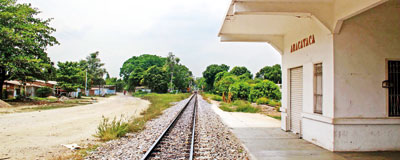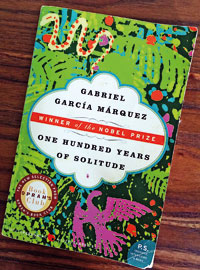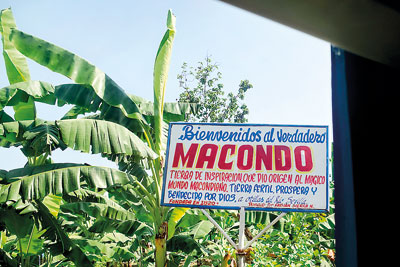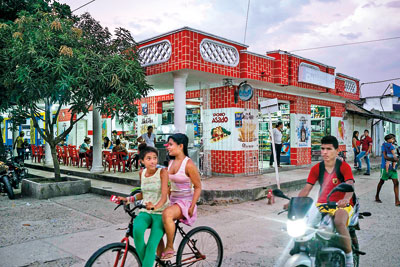In search of echoes of a novel
Have you heard the story about Gabriel García Márquez’s 80th birthday party? Gabo was famous by this time, his years as a poverty stricken journalist having given way to his career as Colombia’s most famous novelist. At 55, he had become the first of his countrymen to win a Nobel Prize for Literature. At 80, he was being asked to return to where it all began. He had not been to Aracataca in 25 years, and yet it was much the same. Thirteen-hours away from Bogota, it remained a dusty, rural town; home to just 25,000 people.
 It was famous, however, by another name. If you were looking for Macondo, the fictional town at the heart of One Hundred Years of Solitude -Gabo’s most famous book – you would begin your search in Aracataca. You are introduced to Macondo in the first few pages of the book, as the second generation of the Buendía family faces a firing squad. Over the course of the novel, you see the town founded and watch the gypsies arrive. The Buendías multiply. You stay awake through a plague of insomnia; You stand by as the banana company arrives and departs;You hear rumours of distant wars until fighting erupts on these streets; You survive a torrential rain that lasts four years, eleven months, and two days, until finally, you witness the destruction of a whole town by a hurricane as a man stands by, reading its history.
It was famous, however, by another name. If you were looking for Macondo, the fictional town at the heart of One Hundred Years of Solitude -Gabo’s most famous book – you would begin your search in Aracataca. You are introduced to Macondo in the first few pages of the book, as the second generation of the Buendía family faces a firing squad. Over the course of the novel, you see the town founded and watch the gypsies arrive. The Buendías multiply. You stay awake through a plague of insomnia; You stand by as the banana company arrives and departs;You hear rumours of distant wars until fighting erupts on these streets; You survive a torrential rain that lasts four years, eleven months, and two days, until finally, you witness the destruction of a whole town by a hurricane as a man stands by, reading its history.
But in Aracataca, the dream of Macondo survived. It was where Gabo was being asked to return for the birthday party to end all birthday parties. The authorities shared their plans to inaugurate the Macondo Express. The promise was that the new line would bring tourists and prosperity to the town.
The train carriages would be painted a happy colour and decorated with the yellow butterflies that had come to be associated with Gabo.Gabo made the trip and arrived to find thousands of people waiting to meet him. There was a parade and a marching band. All of his oldest friends were there. Journalists from The Guardian and the New York Times covered the event. Gabo was overwhelmed.
But, a few weeks later, when the writer had an inquiry made about the new express connection, he found out that soon after his arrival, the new carriages had simply been loaded onto trucks and taken away. The publicity stunt had had a shelf life of a few hours. There would be no express connection to the Aracataca. In truth, no one was surprised.
Memories of a massacre
So you travel to Aracataca not by train, but by bus. It’s three hours away from Cartagena de Indies and out of the window you see small villages, and homes built on stilts in the marshlands. Mangroves cover long stretches on your right and on your left, the Caribbean glints in the noonday Sun. (You remember then José Arcadio Buendía setting out from Macondo only to find it is surrounded by water on all sides).
To travel in this part of Colombia, with a book by Gabo in your hands, is to find the fact in the fiction. The events and characters from the book, that seemed so fantastical when you first read about them, make perfect sense here. But perhaps that is only because you are a stranger, and eager to find echoes of a novel you love, in the landscape you are discovering.
Soon, you abandon the coast, turning inland to where mountains lie cloaked in thick forests. This is banana country, and the plantations stretch out on both sides of the road. Once American banana companies brought wealth and suffering to Aracataca. In the town of Ciénaga you see the evidence of a fraught past – here a solemn memorial to the massacred United Fruit workers takes the shape of a tall statue in the main plaza. The figure brandishes a machete in his right hand.
 Do you remember that moment in One Hundred Years of Solitude? The day when the banana plantation workers, in the middle of their general strike over their dismal working conditions, gather in protest? It is a crowd of 3,000 – men, women and children – who are told they can present their case to the province’s civil and military leader.
Do you remember that moment in One Hundred Years of Solitude? The day when the banana plantation workers, in the middle of their general strike over their dismal working conditions, gather in protest? It is a crowd of 3,000 – men, women and children – who are told they can present their case to the province’s civil and military leader.
But no dignitary steps down from the train. Instead an official reads out a decree that gives the “bunch of hoodlums” five minutes to disperse. No one moves, until the soldiers start firing into the crowd. The hail of bullets finds every target except one. In the eerie silence that follows, all the bodies, only one of whom is alive, are loaded on a train headed for the coast; the ocean will be their grave. When José Arcadio Segundo awakes in a nest of corpses, escape means jumping off the train and walking back to Macondo. But he finds Macondo is in denial and no one in the town will believe him. Eventually, all traces of the brutal murders are wiped from existence and memory.
Gabo did not invent the massacre, as Ciénaga can testify. The United Fruit Company existed, and still does exist in other guises. However, Gabo freely admitted to taking literary licence with the facts. We do not know, for instance how many died, or who gave the orders. Cover-ups and political machinations have long muddied these waters.
Today, in Aracataca, it can feel like horrors are both forgotten and forgiven. Time has left only a nostalgia for the days of the banana plantations, when there were jobs to be had, and prosperity was possible.
Your bus takes you on a short trip, to deliver you to the stairs of a house in a state of advanced dilapidation. The man who lives inside tells you it used to belong to the banana company. The last foreign occupant was an American who was a reliable shot. As a young boy, your host heard the story of how the American turned his rifle on striking banana plantation workers as they gathered outside his door.
Your host’s name is Jorge Leal Molina. His parents bought this house, a long time after the American had deployed his weapon in rage and fear. There was a time when Jorge wanted nothing to do with this place. He left the ‘banana zone’, left the Caribbean coast, and went looking for a life in Spain, where his grandmother had once lived.
The news of the assassinations brought him back.
They found his mother first, dead from the bullet in her chest. His brother lay not far from her, shot in the back of the head. Jorge would eventually discover what had happened, how the guerrilla group known as The Revolutionary Armed Forces of Colombia (FARC) had kidnapped a relative his mother trusted, and had forced him to come back and kill her.
Having now returned, Jorge has chosen not to leave. He has become a local leader, a voice for victims of a conflict that pitted the state against guerrilla groups for 52 years. A tenuous peace deal was signed in 2016, but with half the country against it, it can seem that every day the uncertainties multiply. In the middle of this, Jorge intends to run for mayor.
His courage, his capacity for optimism, for hope, feels familiar to you. It is the same on the island where you live.

Now there’s only nostalgia for the prosperous days of the banana company. Pic by Joaquin Sarmiento
A museum more magical then real
Your arrival in Aracataca has been timed to coincide with the 50th anniversary of the publication of One Hundred Years of Solitude. A sign on one wall welcomes us to the ‘Land of the Nobel’, another bears testimony to the place the sleepy town held in Gabo’s life and work: ‘Aracataca,’ reads the quote from the author,‘to which I returned one day and discovered that between reality and nostalgia was the raw material for my work.’
Your first stop is the railway station. You watch in wonder as the longest train that any of you has ever seen passes by; some 300 carriages loaded with ore from the mines thunders down the track without pause. Another one of these monsters trundles by every thirty minutes. (When the train first arrived in Macondo, a woman is driven mad by the strangeness of a machine so loud that it sounds like “the kitchen dragging a village behind it.”)
From the houses nearby, the sounds of salsa are carried over by the wind.
Wandering through this town, you watch locals as they watch you. Your arrival appears to be the most interesting thing to happen today. In your survey of the town, you discover most of the roads are unpaved. They are lined by mango trees, heavy with small, sweet fruit; when you eat one, you stain your white dress. The homes that line the dusty streets are simple and a long drought means few have running water. The town square is overrun with young children playing run and catch. Your host is a family in the village. You find loose pills on the mattresses in the doctor’s spare bedroom.
The big tourist attraction is the museum dedicated to Gabo. It is supposed to be his house, and yet his house was burned down to the ground many years ago. This unfaithful reconstruction includes bedrooms, a smithy for the making of gold fish and a study for his grandfather. A bunch of bananas hangs in the corner of the dining room, with helpful directions for anyone who has never sampled one before: ‘You have to peel it before you eat it.’Everything here is a recreation; a kind of architectural magical realism.
Aracataca has long been embroiled in a fight to claim Gabo. They have little to show for it. Gabo’s ashes are divided between Mexico City (where he spent much of his life in exile) and Cartagena de Indies. In 2014, the Harry Ransom Center at University of Texas celebrated the acquisition of his archive, including an unfinished novel. When the authorities set about building the museum in 2006, Gabo reviewed the blueprints of the $350,000 restoration but had little else to do with the project.
You are not entirely surprised to discover that people in this town are divided about Gabo. Over the years, residents have complained to visiting journalists with some bitterness of neglect; their most famous son should have given money to this town, they say, or at least arranged to give back to them after his death. Aracataca is left, for most part, only with memories.
While walking around, you are invited into the home of Aracataca’s former mayor; 86-year-old Carlos Nelson is one of Gabo’s oldest friends. “I drank with him before he was famous,” the bluff old man tells you. Nelson knew the author first when they were both 16, and then again when Gabo was deported from Venezuela. Gabo came back then as an encyclopaedia salesman. His profits never seemed to stretch much further than his next bottle of pure cane rum.

A day in the life of the locals of Aracataca. Pic by Stephen Ferry
“The bottle cost 60 cents at that time,” says Nelson.“I remember when he came, he would come crying: ‘I sold one, I sold one.’” The profits from the encyclopaedia sales went towards a worthy cause. “We would sit up and drink till eight or ten at night, and then start again the next day at noon. Sometimes we would steal chickens and cook them the following day.”
Aracataca was different then, remembers Nelson. “It was a small town. There was no aqua duct, and the water used to be delivered by truck. Everybody knew everybody else, and we slept with our doors open.” Today, Aracataca has many faces, as thousands of internally displaced people have been driven out of areas occupied by the guerrilla and right-wing paramilitary groups. It is hard to find work, and the community is beset with drug-related crimes.
Does Nelson recognize Aracataca in Macondo?
They are nothing alike, Gabo’s old friend tells you, his face closing off at what must be the most predictable of questions. “It’s completely different.”
The author is a Gabriel García Márquez Cultural Journalism Fellow for 2017.


